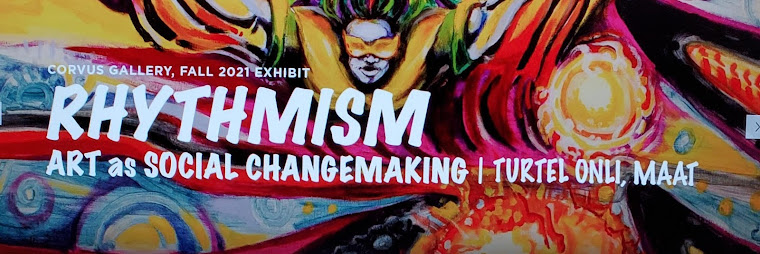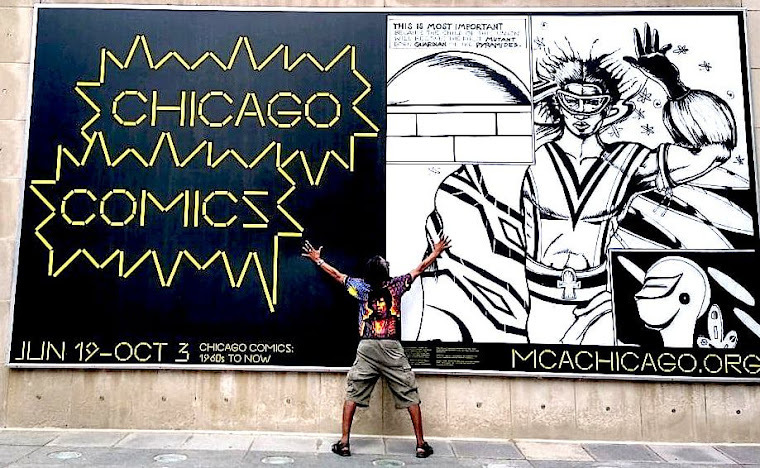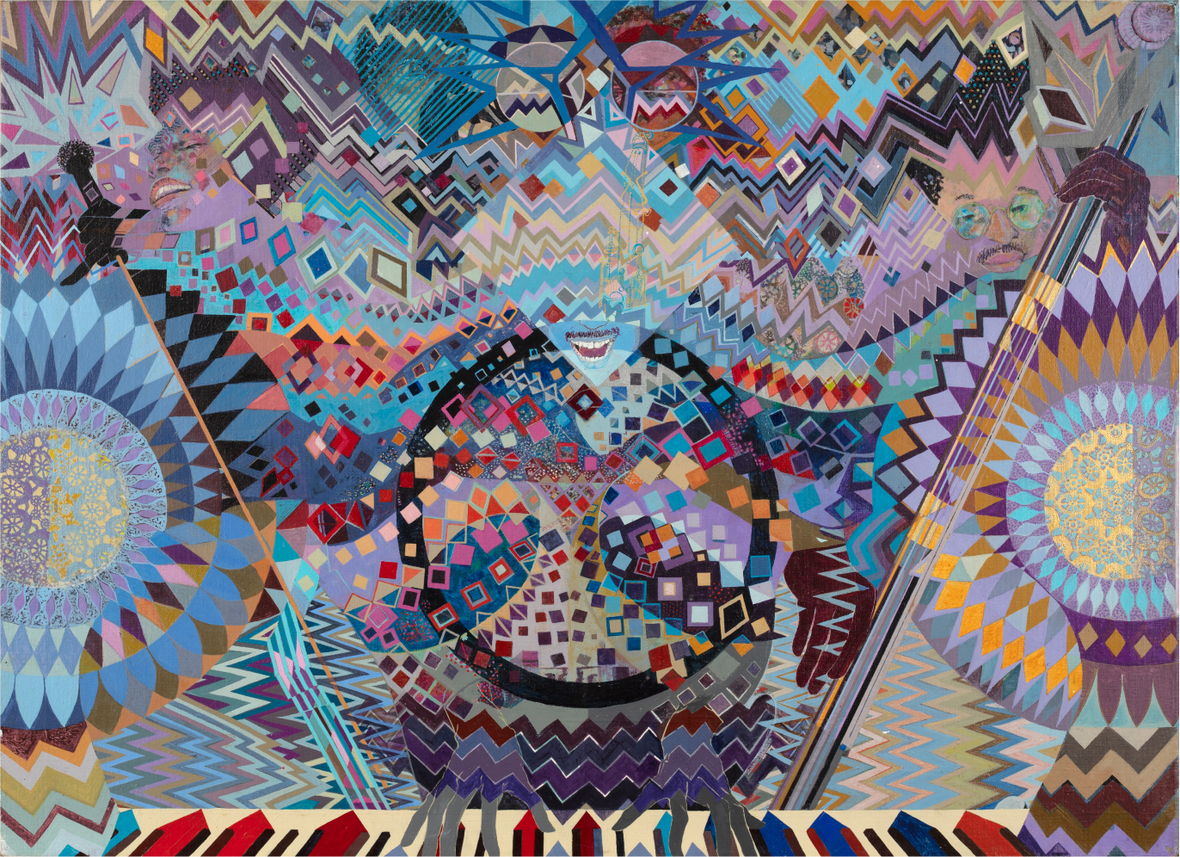
Afro Futuristic visual art is born of Rhythmism! Onli's Future-Primitif works have been shown to positive acclaim with The Museum of Contemporary Art, Chicago, Cool Globes, The Tubman Museum, New Museum of Contemporary Art, NY, The Krannert Museum, The DuSable Museum of Black History, The Museum of Science & Industry, Chicago Children's Museum, & The FIAP in Paris. Educators, enthusiasts, collectors, curators, collectors, & critics are.. WELCOME!
"NOG Emerges" 2021 Copyright 2021 Turtel Onli

Inspired by "NOG" being the Future-Primitif face of the blockbuster group exhibition at the change making, trend setting Museum of Contemporary Art, Summer / Fall 2021 called "Chicago Comics: 1960 Until Now", curated by Dan Nadel. . NOG was mural sized on the MCA's outer wall near the door to its Museum Store which featured NOG merchandise in the form of a Tote Bag, post cards, a ever-cool NOG Sketch Book, plus autographed copies of "Tales From The Rhyhthmic Zone", the Graphic Novel that includes expanded versions of the original NOG stories. So Rhythmistic! All artwork on this blog by Prof. Onli is Copyright 2023 Turtel Onli , and other dates. All Rights Protected & not to be remixed, rebooted or used commercially without a signed agreement with Prof. Onli.
Sunday, December 1, 2019
Friday, November 8, 2019
LINK!
“It’s wonderful to be around other artists because they give you ideas that you wouldn’t ever think of,” Frazier says.
Another source of artist inspiration came during her time as a member of the Black Arts Guild (BAG) in Chicago. The Guild, founded by Turtel Onli in 1970, will celebrate a major anniversary next year. Frazier recalls that the Guild’s first studio space was located next to the iconic Operation PUSH! headquarters by Hyde Park, and offered an inspirational environment to work in.
An important artistic element that Frazier carries with her from her early years with BAG, is the recurring use of watermelon in her work. The watermelon is a tribute to the BAG logo, as the group sought to redefine a negative stereotype. It is red, black, and green— the symbolic colors of the Black Liberation movement— and the seeds within “continue life,” she adds. “People of African descent have to decide for themselves who they are.” The watermelon motif can be found in most of her solo works.
For the entire article use the LINK.
From a conversation with Espi Frazier:
“It’s wonderful to be around other artists because they give you ideas that you wouldn’t ever think of,” Frazier says.
Another source of artist inspiration came during her time as a member of the Black Arts Guild (BAG) in Chicago. The Guild, founded by Turtel Onli in 1970, will celebrate a major anniversary next year. Frazier recalls that the Guild’s first studio space was located next to the iconic Operation PUSH! headquarters by Hyde Park, and offered an inspirational environment to work in.
An important artistic element that Frazier carries with her from her early years with BAG, is the recurring use of watermelon in her work. The watermelon is a tribute to the BAG logo, as the group sought to redefine a negative stereotype. It is red, black, and green— the symbolic colors of the Black Liberation movement— and the seeds within “continue life,” she adds. “People of African descent have to decide for themselves who they are.” The watermelon motif can be found in most of her solo works.
For the entire article use the LINK.
Sunday, October 27, 2019
The People Of Color Conference in Seattle Dec. 4th / 7th presented by the National Association of Independent School
Afrofuturism and Social Justice: Ideas Through Art, Literature, and Science
|
A | Thursday, December 5, 1:45 PM-3:00 PM |
Building Capacity: Skills, Competencies, and Processes for Equity, Inclusion, and Social Justice | |
| ||||
Wednesday, October 16, 2019
Friday, October 4, 2019
In the definitive book that serves as a guide for institutions and serious collectors of fine art, "African Art: The Diaspora and Beyond", authored by the dedicated collector of Black & African art Daniel Texidor Parker, in its Chapter III Masters of the Diaspora there is a vital section:" Black Esthetics."
This was book published in 2004.
On page 63 it reads:
"The discussion of Black Aesthetics is ongoing. It ranges from the development of new technology to arts profound effect upon the viewer. We hear the voice of Chicago artist Turtel Onli, who focuses on elements of rhythm and flow in art. The term he uses to express this concept is rhythmism,
Onli says, "This a futuristic approach to visual Africanism that distinguishes the work of many contemporary artists."
Sunday, September 29, 2019
Saturday, August 10, 2019
(AFP).-
Researchers have discovered a series of creativity-linked genes that
may have given Homo sapiens a significant edge over Neanderthals,
enabling them to avoid extinction.
The findings suggest that these genes played "a fundamental role in the evolution of creativity, self-awareness and cooperative behaviour," the multinational research team wrote Wednesday in the Nature journal Molecular Psychiatry. Such genes were like "a secret weapon" that gave modern humans "a significant advantage over now-extinct hominids by fostering greater resilience to ageing, injury, and disease, they wrote. Led by Granada University in Spain, the experts identified 267 genes unique to humans, and through genetic markers, genetic expression data and AI-related MRI techniques, found they were related to creativity. "The scientists were able to identify the regions of the brain in which those genes (and those with which they interacted) were overexpressed," they wrote. These regions are involved in human self-awareness and creativity, and include the regions that are strongly associated with human well-being and that appeared relatively recently." Previously, the same team had identified a pool of 972 genes organised into three brain networks, the oldest -- which relates to learning habits, social attachment and conflict resolution -- dating back 40 million years. The second network -- which relates to intentional self-control -- emerged 2 million years ago, while the newest, governing creative self-awareness, only emerged 100,000 years ago. " "Thanks to these genes, Homo sapiens enjoyed greater physical fitness than now-extinct hominids, providing them with a superior level of resilience to ageing, injury, and disease," they wrote. "Physical fitness, or resilience, is intrinsic to the definition of creativity," said the study's lead author Igor Zwir. The finding offers fresh insight into the mystery of why Homo sapiens outlived the Neanderthals and other species. The authors said creativity may have encouraged cooperation between individuals which would have set the stage for technological innovation, behavioural flexibility and openness to exploration, enabling them to spread out more successfully than their predecessors. © Agence France-Presse |
Monday, May 27, 2019
Sunday, May 5, 2019
B.A.G. The Black Arts Guild
Circa 1970-1978
2020 will be the 50th anniversary of the launch of the self-sustained youthful and gifted Black Arts Guild, B.A.G. Started in Chicago in 1970 by Turtel Onli, B.A.G. and its principal members who were in their late teens and wanted to get past the restraints of ageism and orthodoxy in the arts community to make the transition from young talented students to competitive professional artists and arts educators.
They also wanted to morph ideas and styles emerging from the Black Cultural revolution into the mainstream. It served this purpose from 1970 until 1978. B.A.G. produced a variety of exhibitions, products, embraced the health giving watermelon as its logo and its members went on to earn degrees, become illustrators for the likes of Essence Magazine, The Paris Metro Magazine, Motown Corp, Johnson Publishing Company, and interned with the textile designer Robert E. Paige's One - of-a-Kind Studios. Including becoming certified arts educators with various school systems.
Founder Prof. Turtel Onli is planning a series of TBA exhibitions, lectures and more in tribute to the launch, life and legacy of B.A.G. The Black Arts Guild. Its principle members were Jim Smoote, Dalton Brown, Greg Broils, Obie Creed, Kenneth Hunter, Espi Frazier, Judith Lee, and Turtel Onli.
Notice has been served!
Dalton Brown designed the poster above to promote a B.A.G. Group exhibition at the now defunct AFAM Art Gallery in Chicago in 1973. The image above that is a part of a showcase of Brown's artwork in Hyde Park at the Great Frame Up.
Above: Jim Smoote shown with one of his masterful quilts. Smoote was a critical member of B.A.G. He served as its Treasure and his meticulous prolific work ethic help set the tone and pace for productivity within this guild.
Espi Frazier's rigorous Wood Graphics and other works are still potent and full of a beauty & power that speaks volumes for her dedication and life as an artist.
The Rhythmistic illustrations and graphic design work of B.A.G .members Kenneth Hunter and Turtel Onli are featured in the amazingly historic and intelligently crafted album cover sized book, "Freedom: Rhythm & Sound.
This is an article that ran in the Chicago Tribune newspaper in 1991 where Dalton Brown along with Turtel Onli were interviewed about B.A.G. and its impact.
May 11 – November 24, 2019
Ca’ Faccanon, Calle delle Acque,
|
|
AFRICOBRA: Nation Time is a Collateral Event of the 58th International Art Exhibition – La Biennale di Venezia
AFRICOBRA: Nation Time will be presented as an official Collateral Event of Biennale Arte 2019 in Venice, Italy. Founded over 120 years ago, the Venice Bienniale is the oldest and most prestigious biennial in the world. The exhibition, on view from May 11 – November 24, 2019, will mark the first exhibition from South Florida to be represented on the important international platform.
AFRICOBRA: Nation Time at Biennale Arte 2019 is the first time the work of this vital, definitive, and historic Black Arts collective has been celebrated by global audiences on this scale. AFRICOBRA was founded on the South Side of Chicago in 1968 by a collective of young Black artists, whose interest in Transnational Black Aesthetics led them to create one of the most distinctive visual voices in 20th Century American art. The key characteristics to what we now consider the classic AFRICOBRA look—vibrant, “cool-ade” colors, bold text, shine and positive images of Black people —were essential to everyday life in the community from which this movement emerged. The five AFRICOBRA founders—Jeff Donaldson, Wadsworth Jarrell, Jae Jarrell, Barbara Jones-Hogu and Gerald Williams—understood the potential power visual art has to communicate deep meaning on multiple layers. Their collective impact helped establish the visual voice of the Black Arts Movement of the 1960s and 70s.
|
|
Thursday, April 18, 2019
"Taking this rare moment to be politically incorrect and address the Haters. The ones I opened professional doors to and for. The ones I built an open sourced genre for them to flourish. The ones who will not have the humanity to relate to this and should now stop reading and move elsewhere. Being a life long humanitarian and Rhythmistic Visual Artist who has done things before many of them were born or even thought about. Challenging the norms and limits of this craft. They are so blind to not see the damage of their selfishness. The stealing of ideas beyond their ability to control. The denial of truth covered up in opinons.
The willingness to hide behind Ageism, Racsim, Heterophobia, Self-hatered and classism rather to appreciate this generous practice and its proven potential. But that is what haters do and there is a new hater bred and born every second in this global world of ours."
The willingness to hide behind Ageism, Racsim, Heterophobia, Self-hatered and classism rather to appreciate this generous practice and its proven potential. But that is what haters do and there is a new hater bred and born every second in this global world of ours."
' Now to close that vent and return to the studio and all things Rhythmistic!"
Sharing a 1990 masterwork. Acrylic on canvas.
Wednesday, March 27, 2019
Life in the Arts LINK:
The Black Arts Guild until now and forever. This is about life in the Arts on a massive scale. Flowing out with concepts, skills, ideas and genres that have launched or recovered careers.
Shown in the above photo: The late Kenneth Hunter, non B.A.G. member noted photographer Roy Lewis, Espi Frazier and Turtel Onli. Taken in 1972 at the National Conference of Artists Convention in Washington DC at Howard University.
Photo by B.A.G. member Jim Smoote
Shown in the above photo: The late Kenneth Hunter, non B.A.G. member noted photographer Roy Lewis, Espi Frazier and Turtel Onli. Taken in 1972 at the National Conference of Artists Convention in Washington DC at Howard University.
Photo by B.A.G. member Jim Smoote
Subscribe to:
Posts (Atom)































